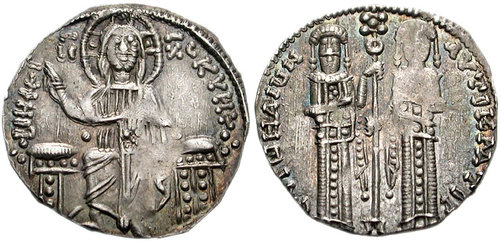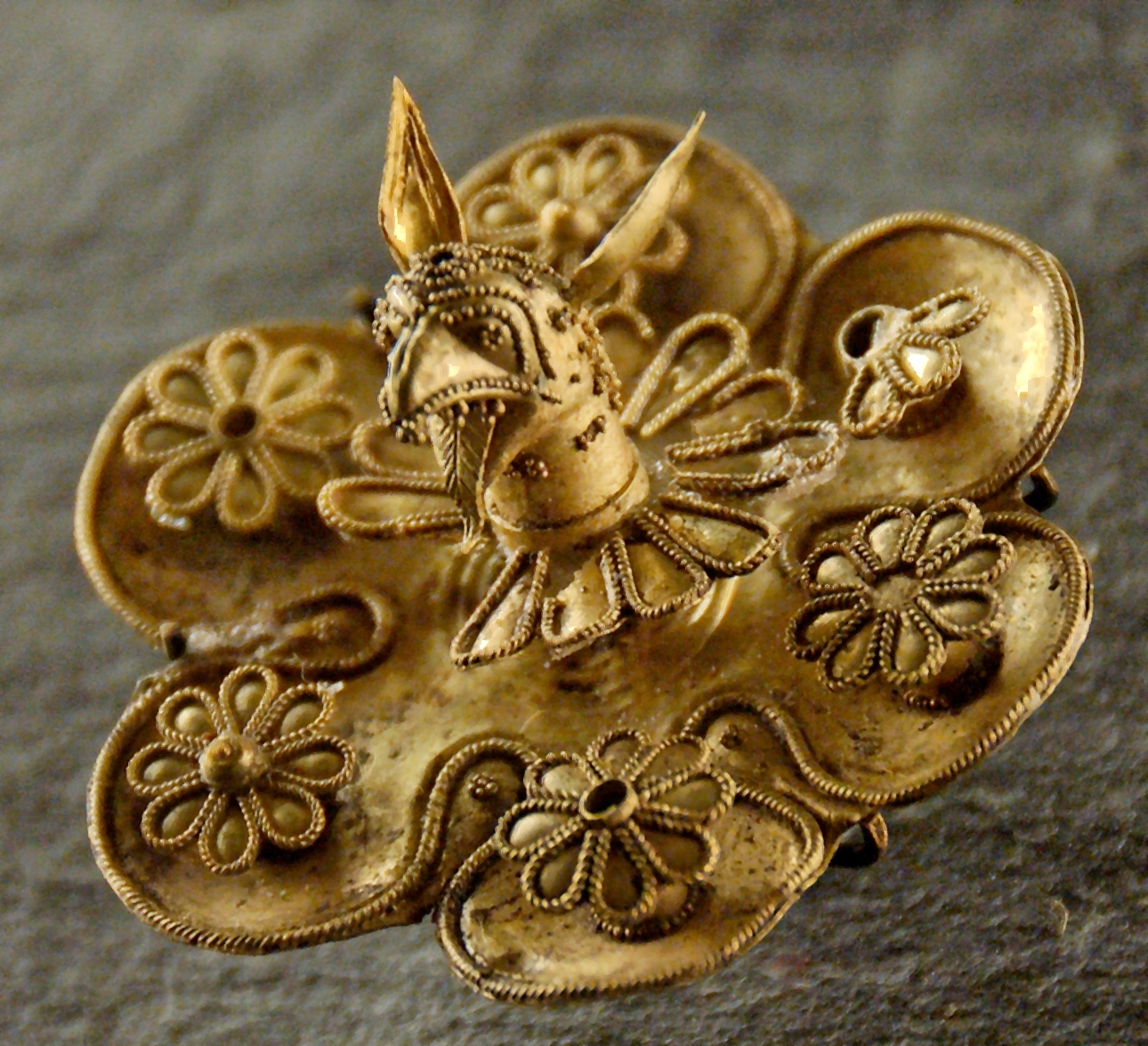|
Hyperper
The ''hyperpyron'' (, ''nómisma hypérpyron'' ) was a Byzantine coin in use during the late Middle Ages, replacing the ''solidus'' as the Byzantine Empire's standard gold coinage in the 11th century. It was introduced by emperor Alexios I Komnenos. History The traditional gold currency of the Byzantine Empire had been the ''solidus'' or ''nomisma'', whose gold content had remained steady at 24 carats for seven centuries and was consequently highly prized. From the 1030s, however, the coin was increasingly debased, until in the 1080s, following the military disasters and civil wars of the previous decade, its gold content was reduced to almost zero. Consequently, in 1092, Emperor Alexios I Komnenos ( 1081–1118) undertook a drastic overhaul of the Byzantine coinage system and introduced a new gold coin, the ''hyperpyron'' (meaning "super-refined"). This was of the same standard weight (4.45 grams) as the ''solidus'', but only 20.5 carat purity (0.854 fineness) instead of the stand ... [...More Info...] [...Related Items...] OR: [Wikipedia] [Google] [Baidu] [Amazon] |
Balkans
The Balkans ( , ), corresponding partially with the Balkan Peninsula, is a geographical area in southeastern Europe with various geographical and historical definitions. The region takes its name from the Balkan Mountains that stretch throughout the whole of Bulgaria. The Balkan Peninsula is bordered by the Adriatic Sea in the northwest, the Ionian Sea in the southwest, the Aegean Sea in the south, the Turkish straits in the east, and the Black Sea in the northeast. The northern border of the peninsula is variously defined. The highest point of the Balkans is Musala, , in the Rila mountain range, Bulgaria. The concept of the Balkan Peninsula was created by the German geographer August Zeune in 1808, who mistakenly considered the Balkan Mountains the dominant mountain system of southeastern Europe spanning from the Adriatic Sea to the Black Sea. In the 19th century the term ''Balkan Peninsula'' was a synonym for Rumelia, the parts of Europe that were provinces of the Ottoman E ... [...More Info...] [...Related Items...] OR: [Wikipedia] [Google] [Baidu] [Amazon] |
Medieval Bulgarian Coinage
Medieval Bulgarian coinage were the coins minted by the Bulgarian Emperors during the Middle Ages at the time of the Second Bulgarian Empire. There is no evidence that coins were minted during the First Bulgarian Empire, and minting ceased after the fall of the Second Empire with Ottoman domination in 1396. They were gold (''perperi''), silver (''aspri''), billon (coinage of silver and copper) and copper coins, all flat and hollow. The inscriptions were usually in Bulgarian language and rarely in Greek. Due to the limited space the inscriptions were abbreviated, often written with a few letters and special signs. Artistically, they continued the Byzantine numismatic tradition but the designs were often more schematic. The main means of expression were lines and dots. The Bulgarian coins had images different from the Byzantine and Slav coinage, so they form a distinct group. The coins are an important source for the history of the Second Bulgarian Empire. Ivan Asen II Tsar ... [...More Info...] [...Related Items...] OR: [Wikipedia] [Google] [Baidu] [Amazon] |
Assarion
The ' (: '), occasionally ''assarius'' (: ''assarii''; ), was a bronze, and later copper, coin used during the Roman Republic and Roman Empire. Republican era coinage The Romans replaced the usage of Greek coins, first by bronze ingots, then by disks known as the ''aes rude''. The system thus named ''as'' was introduced in ca. 280 BC as a large cast bronze coin during the Roman Republic. The following fractions of the were also produced: the (), (), (), (), (), (), (, also a common weight unit), and (), as well as multiples of the ''as'', the (2), (2), and (3). After the ''as'' had been issued as a cast coin for about seventy years, and its weight had been reduced in several stages, a ''as'' was introduced (meaning that it weighed one-sixth of a pound). At about the same time a silver coin, the ''denarius'', was also introduced. Earlier Roman silver coins had been struck on the Greek weight standards that facilitated their use in southern Italy and across th ... [...More Info...] [...Related Items...] OR: [Wikipedia] [Google] [Baidu] [Amazon] |
Tornese
The tornesel, tornesol, or was a silver coin of Europe in the Late Middle Ages and the early modern era. History It took its name from the ', the of Tours. Marco Polo referred to the tornesel in recounts of his travels to East Asia when describing the currencies of the Yuan Empire.Henry Yule''The Travels of Marco Polo: The Complete Yule-Cordier Edition'' Third edition (1903), revised and updated by Henri Cordier. Plain Label Books. p. 1226-27. () His descriptions were based on the conversion of 1 bezant = 20 groats = 133⅓ tornesel. The ' was a subunit of the Neapolitan, Sicilian, and Two Sicilies ducats. See also *History of coins in Italy Italy has a long history of different coinage types, which spans thousands of years. Italy has been influential at a coinage point of view: the medieval Florentine florin, one of the most used coinage types in European history and one of the m ... References Medieval history of Italy Medieval currencies Coins of Italy ... [...More Info...] [...Related Items...] OR: [Wikipedia] [Google] [Baidu] [Amazon] |
Basilikon
The ''basilikon'' (, "imperial oin), commonly also referred to as the (Greek: δουκάτον), was a widely circulated Byzantine silver coin of the first half of the 14th century. Its introduction marked the return to a wide-scale use of silver coinage in the Byzantine Empire, and presaged the total abandonment of the gold coins around the middle of the century. History The ''basilikon'' was introduced shortly before 1304 by Emperor Andronikos II Palaiologos (r. 1282–1328), in direct imitation of the Venetian silver ducat or '' grosso'', chiefly to pay the mercenaries of the Catalan Company... The Byzantine coin closely followed the iconography of the Venetian model, with a seated Christ on the obverse and the two standing figures of Andronikos II and his son and co-emperor Michael IX Palaiologos (r. 1294–1320) replacing St. Mark and the Doge of Venice on the reverse. The similarity was reinforced by the name of the new coin: the ''ducato'', the "coin of the doge", becam ... [...More Info...] [...Related Items...] OR: [Wikipedia] [Google] [Baidu] [Amazon] |
Tetarteron
The ''tetarteron'' (, "quarter [coin]") was a Byzantine Empire, Byzantine term applied to two different coins, one gold circulating from the 960s to 1092 in parallel to the ''histamenon'', and one copper used from 1092 to the second half of the 13th century. Gold coin Ever since Emperor Constantine I (r. 306–337), the Byzantine Empire's main coinage had been the high-quality ''solidus (coin), solidus'' or ''nomisma'', which had remained standard in weight and gold content through the centuries. The Emperor Nikephoros II Phokas (r. 963–969), however, introduced a new coin which was a 2 carats (i.e. about 1⁄12, despite its name) lighter than the original ''nomisma'', which now became known as the ''histamenon''... The exact reason for the introduction of the ''tetarteron'' is unclear. According to the historian Joannes Zonaras, Zonaras, this was done to increase state revenues: the taxes were to be paid as before in the ''histamenon'', while the state paid its own expenses in ... [...More Info...] [...Related Items...] OR: [Wikipedia] [Google] [Baidu] [Amazon] |
Copper
Copper is a chemical element; it has symbol Cu (from Latin ) and atomic number 29. It is a soft, malleable, and ductile metal with very high thermal and electrical conductivity. A freshly exposed surface of pure copper has a pinkish-orange color. Copper is used as a conductor of heat and electricity, as a building material, and as a constituent of various metal alloys, such as sterling silver used in jewelry, cupronickel used to make marine hardware and coins, and constantan used in strain gauges and thermocouples for temperature measurement. Copper is one of the few metals that can occur in nature in a directly usable, unalloyed metallic form. This means that copper is a native metal. This led to very early human use in several regions, from . Thousands of years later, it was the first metal to be smelted from sulfide ores, ; the first metal to be cast into a shape in a mold, ; and the first metal to be purposely alloyed with another metal, tin, to create bronze, ... [...More Info...] [...Related Items...] OR: [Wikipedia] [Google] [Baidu] [Amazon] |
Billon (alloy)
Billon () is an alloy of a precious metal (most commonly silver, but also gold) with a majority base metal content (such as copper). It is used chiefly for making coins, medals, and token coins. The word comes from the French , which means 'log'. History The use of billon coins dates from ancient Greece and continued through the Middle Ages. During the sixth and fifth centuries BC, some cities on Lesbos used coins made of 60% copper and 40% silver. In both ancient times and the Middle Ages, leaner mixtures were adopted, with less than 2% silver content. Billon coins are perhaps best known from the Roman Empire, where progressive debasements of the Roman ''denarius'' and the Roman provincial '' tetradrachm'' in the third century AD led to declining silver and increasing bronze Bronze is an alloy consisting primarily of copper, commonly with about 12–12.5% tin and often with the addition of other metals (including aluminium, manganese, nickel, or zinc) and sometim ... [...More Info...] [...Related Items...] OR: [Wikipedia] [Google] [Baidu] [Amazon] |
Trachy (currency)
The term ''trachy'' (), plural ''trachea'' (τραχέα), meaning "rough" or "uneven", was used to describe the cup-shaped (incorrectly often called "scyphate") Byzantine coins struck in the 11th–14th centuries. The term was properly applied to coins of electrum, billon (alloy), billon, or copper, and not to the gold ''hyperpyra''. During the short lifespan of the feudal Crusader state, the Latin Empire of Constantinople (1204–1261) also used the trachy. References Sources * Coins of the Byzantine Empire Numismatic terminology {{Byzantine-stub ... [...More Info...] [...Related Items...] OR: [Wikipedia] [Google] [Baidu] [Amazon] |
Electrum
Electrum is a naturally occurring alloy of gold and silver, with trace amounts of copper and other metals. Its color ranges from pale to bright yellow, depending on the proportions of gold and silver. It has been produced artificially and is also known as "Colored gold#Green gold, green gold".Emsley, John (2003Nature's building blocks: an A–Z guide to the elements Oxford University Press. p. 168. . Electrum was used as early as the third millennium BC in the Old Kingdom of Egypt, sometimes as an exterior coating to the pyramidion, pyramidia atop ancient Egyptian pyramids and obelisks. It was also used in the making of ancient Beaker (archaeology) , drinking vessels. The first known metal coins made were of electrum, dating back to the end of the 7th century or the beginning of the 6th century BC. Etymology The name ''electrum'' is the Latinized form of the Greek language, Greek word ἤλεκτρον (''ḗlektron''), mentioned in the ''Odyssey'', referring to a metallic s ... [...More Info...] [...Related Items...] OR: [Wikipedia] [Google] [Baidu] [Amazon] |






